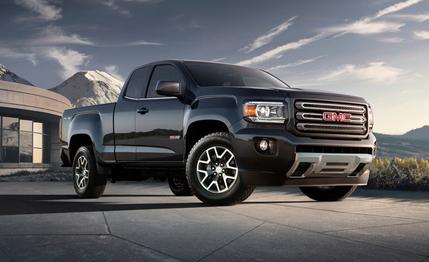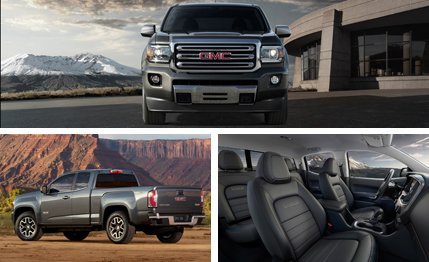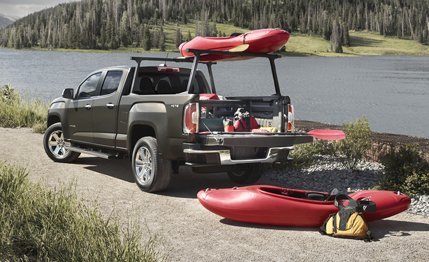
 First Drive Review
First Drive Review
General Motors has done a remarkable job of keeping its GMC and Chevrolet truck brands unique, even though they share virtually identical DNA. Both brands maintain loyal customers, and through careful analysis of buyer demographics, the carmaker continues to nurture the success of both. Thus, it didn’t stray far from the path when it came time to launch its latest pair of near-identical twins, the mid-size GMC Canyon and Chevrolet Colorado pickups. (You can read our first drive of the Colorado right here.)
No design barriers were broken with the Canyon, GMC wisely choosing to adhere to the same styling cues that keep buyers lining up for its full-size trucks. According to Tyler Moffett, creative designer for the Chevrolet trucks, his team went for the “Camaro of trucks” vibe with the Colorado, whereas the GMC guys went straight for the “shrunken-down Sierra” look. GMC made sure to bake in some tasty standard features along with the brand’s traditional squared-off profile to keep the cash train rolling for what is ostensibly the slightly more posh version of the twins.


Projector-beam headlamps with LED accent lighting, 16-inch aluminum wheels, and a chrome rear bumper with a step come standard across the Canyon board, even on the rock-bottom SL trim with its utilitarian 2.4-liter four-cylinder and six-speed manual. Despite the austerity implied by its name, the “Base” Canyon is actually placed above the SL in the Canyon’s trim hierarchy; both come equipped with a complement of standard features that would have been reserved for top-tier trucks just a decade ago: A/C, a tilt wheel, a power driver’s seat (recline is manual), power windows, a 4.2-inch center screen, a rearview camera, and six-speaker audio. Moving up to the SLE will get you all of the features in the base trim and add a tilt and telescopic wheel, an overhead console, cruise control, a rear defogger, keyless entry, some soft-touch plastics, an eight-inch touch screen with GMC IntelliLink, and more. The SLT approaches content overload, adding automatic climate control, remote start, leather-appointed seating, heated front seats, and power adjustment for the front passenger seat. But that’s just for starters. GMC has always been fond of its extensive options lists, and buyers won’t be disappointed here.
Not only smaller in stature than the Sierra, the Canyon is intended to feel less daunting around town and in parking lots, key to bringing folks who defected to crossovers back into the truck fold and to making newbies feel less intimidated. Wheeling through the narrow, cottage-lined streets of ocean-side Del Mar, California, it felt infinitely more wieldy than even the smallest full-size truck. Critics who contend that the long-bed Crew Cab Canyon is nearly the size of a Sierra Double Cab (224.6 inches long and 74.3 inches wide for the Canyon versus 229.5 and 80.0 for the Sierra) are advised to get behind the wheel and experience how shaving a few inches here and there can make a vehicle feel far smaller.
The same quiet cabin and smooth ride we experienced in the Colorado are present in the Canyon, two attributes missing from the current Toyota Tacoma and the departed Ford Ranger. Because of the GMC’s well-sorted chassis, Canyon owners will have no complaints at the end of high-mileage journeys. Unique to the Canyon is an automatic four-wheel-drive setting. Dubbed AutoTrac, it allows users to set it and forget it, letting the system engage four-wheel drive when conditions dictate. Particularly useful when inclement weather looms or when traveling through varied terrain, it had no ill effects on drivability and displayed no binding when we used it on dry pavement. Those serious about off-roading will want to remember that GMC calls its version of the off-road package the “All-Terrain Package” (Chevy’s is Z71). It brings an automatic-locking rear differential and tow hooks (both standard with four-wheel drive), hill-ascent and -descent control, a transfer-case shield, 17-inch 255/65 all-terrain tires, a body-color rear bumper, and some minor interior tweaks designed to keep things comfortable inside while roughing on the outside.


With an EPA fuel-economy rating of 17 mpg city and 24 highway for a truck equipped with the V-6 and four-wheel drive, the Canyon—and the Colorado, for that matter—may not have hit the efficiency home run some were hoping for, but it still handily beats the Tacoma, and a diesel model is scheduled to arrive next year. And like its Chevy sibling, a Canyon equipped with the 3.6-liter V-6 and the $250 trailering package can tow 7000 pounds—at that cost, we wouldn’t leave home, er, the dealership, without it.
GM says the Canyon is the “premium truck in the segment,” which, given its distinct lack of competitors, is a bit like saying that Google is a popular search engine. Still, the brand has come to the table with a convincing package that hits all the right marks for a truck in an easy-to-manage package. The question is whether buyers in the mid-size-truck segment will pony up the premium simply for the privilege of associating with the more prestigious twin.